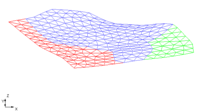GMS:2D Mesh Display Options: Difference between revisions
From XMS Wiki
Jump to navigationJump to search
No edit summary |
No edit summary |
||
| Line 1: | Line 1: | ||
{{2D Mesh links}} | {{2D Mesh links}} | ||
The properties of all [[GMS:2D Mesh Module|2D mesh]] data that GMS displays on the screen can be controlled through the ''2D Mesh'' tab of the [[GMS:Display Options|''Display Options'']] dialog. This dialog is opened by right-clicking on the 2D Mesh Data [[Image:2DMeshFolder.png]] entry in the [[GMS:Project Explorer|Project Explorer]] and selecting the '''Display Options''' command. It can also be accessed from the from the ''Display'' menu or the '''Display Options''' [[File:Display Options | The properties of all [[GMS:2D Mesh Module|2D mesh]] data that GMS displays on the screen can be controlled through the ''2D Mesh'' tab of the [[GMS:Display Options|''Display Options'']] dialog. This dialog is opened by right-clicking on the 2D Mesh Data [[Image:2DMeshFolder.png]] entry in the [[GMS:Project Explorer|Project Explorer]] and selecting the '''Display Options''' command. It can also be accessed from the from the ''Display'' menu or the '''Display Options''' [[File:Display Options Macro.svg|16 px]] macro. The following table describes the display options available for the 2D Mesh module. | ||
{| class="wikitable" | {| class="wikitable" | ||
